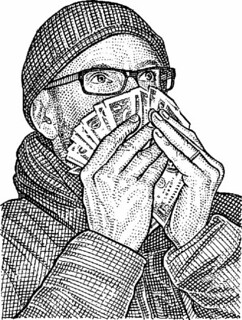
PREV ARTICLE
FULL ISSUE
PREV FULL ISSUE
THE SWEET SMELL OF MONEY
The January 20, 2017 Wall Street Journal A-HED piece highlighted a German perfume expert who sought to bottle the scent of money.
-Editor
Customs agents and chemists around the world have long been curious about the exact aroma of the U.S. greenback. The hunt is complicated by the fact that a dollar’s scent evolves as it circulates—from an inky-cotton fragrance fresh from the bank to an earthier, greasy-palm smell that should remind people to wash their hands more often. Marc vom Ende, a chemist and senior perfumer with German flavor and fragrance house Symrise AG, thinks he has hit on the precise blend. Starting with base notes of cotton, soap and ink, Mr. vom Ende says, the scent sweeps in odors derived from more than 100 volatile organic chemicals. It includes whiffs of leather from time spent in wallets and handbags, a metallic tang that evokes cash registers, salty human sweat and even bacterial and bathroom smells. Mike Bouchet, a Frankfurt-based artist who commissioned the scent search, said the first time he stuck his nose into an early sample, "I felt a bump, like a jolt of electricity, because it smelled just like money. It was invigorating." Until now, the smell of U.S. dollars hadn’t been inventoried. When Mr. Bouchet approached Symrise, based in Holzminden, Germany, two years ago with his idea to re-create the used money smell, executives assigned the project to Mr. vom Ende, its 48-year-old senior perfumer who designs scents for diffusers in the interiors of Mercedes-Benz cars as well as European perfume companies. Mr. vom Ende smelled a challenge. "Money takes something from everyone who uses it," he said. "That makes it crazy complex, but that also makes it interesting to detect." To begin, the perfumer inserted a wad of new and used U.S. paper money—in denominations of $1, $5 and $20—into an airtight chamber containing activated charcoal. Like a sponge, the charcoal absorbed elements in or around the dollars in the trapped air, allowing molecules from the money to be extracted. (Different currencies have different smells.) The final formula could prove tempting to counterfeiters seeking to make their fakes "smell authentic," she added. The Secret Service, which oversees efforts to stem financial crimes like money laundering, was intrigued by the idea of re-creating the smell, but said the odor isn’t one of the tools experts currently use to weed out counterfeit currency. The Bureau of Printing and Engraving, which printed 7.6 billion new notes for the Federal Reserve last year, said that the notes’ odor isn’t proprietary, even though some of the manufacturing processes used to make them are protected. For now, the results of Mr. vom Ende’s olfactory detection will be able to be inhaled in only one place: New York gallery Marlborough Chelsea, where the perfumer plans to come to turn over his vial to Mr. Bouchet, the artist who paid Symrise to produce it. Mr. Bouchet is known for making wry artworks exploring commercial processes. He has created his own bluejeans, cans of hamburger and flavored cola. On Thursday, he intends to diffuse the smell throughout the gallery—as a work of art.
Notwithstanding earlier studies of bills circulating in Chicago and Miami, nary a single molecule of cocaine was found.
-Editor
The biggest group were aliphatic aldehydes, a dominant smell in soap, linen and "a key smell in Chanel No. 5," he said. People typically find such compounds appealing, he added, "unless it gets too strong, and then we think it smells like vomit." Next, he found high amounts of alkanes, or compounds we often find in gasoline or ink. The rest were largely animal-derived, he said, coming from body oils, skin cells and decay. He also found the presence of butter, cheese and hay as well as indole molecules, which are commonly found in fecal matter. "I found more than I expected," he said.
Vegans dislike handling polymer banknotes, which are manufactured with trace amounts of animal tallow. But there's no escaping these trace amounts - all banknotes carry
animal-derived compounds.
-Editor
To read the complete article (subscription required), see:
The Numismatic Bibliomania Society is a non-profit organization promoting numismatic literature. See our web site at coinbooks.org. To submit items for publication in The E-Sylum, write to the Editor at this address: whomren@gmail.com To subscribe go to: https://my.binhost.com/lists/listinfo/esylum All Rights Reserved. NBS Home Page Contact the NBS webmaster 
|
